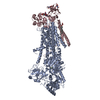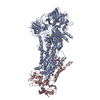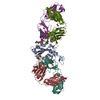[English] 日本語
 Yorodumi
Yorodumi- PDB-3wlw: Molecular Architecture of the ErbB2 Extracellular Domain Homodimer -
+ Open data
Open data
- Basic information
Basic information
| Entry | Database: PDB / ID: 3wlw | |||||||||
|---|---|---|---|---|---|---|---|---|---|---|
| Title | Molecular Architecture of the ErbB2 Extracellular Domain Homodimer | |||||||||
 Components Components |
| |||||||||
 Keywords Keywords | HYDROLASE/IMMUNE SYSTEM / HYDROLASE-IMMUNE SYSTEM complex | |||||||||
| Function / homology |  Function and homology information Function and homology informationnegative regulation of immature T cell proliferation in thymus / ERBB3:ERBB2 complex / ERBB2-ERBB4 signaling pathway / GRB7 events in ERBB2 signaling / immature T cell proliferation in thymus / RNA polymerase I core binding / regulation of microtubule-based process / ErbB-3 class receptor binding / semaphorin receptor complex / Sema4D induced cell migration and growth-cone collapse ...negative regulation of immature T cell proliferation in thymus / ERBB3:ERBB2 complex / ERBB2-ERBB4 signaling pathway / GRB7 events in ERBB2 signaling / immature T cell proliferation in thymus / RNA polymerase I core binding / regulation of microtubule-based process / ErbB-3 class receptor binding / semaphorin receptor complex / Sema4D induced cell migration and growth-cone collapse / motor neuron axon guidance / neurotransmitter receptor localization to postsynaptic specialization membrane / PLCG1 events in ERBB2 signaling / ERBB2-EGFR signaling pathway / neuromuscular junction development / positive regulation of Rho protein signal transduction / ERBB2 Activates PTK6 Signaling / Drug-mediated inhibition of ERBB2 signaling / Resistance of ERBB2 KD mutants to trastuzumab / Resistance of ERBB2 KD mutants to sapitinib / Resistance of ERBB2 KD mutants to tesevatinib / Resistance of ERBB2 KD mutants to neratinib / Resistance of ERBB2 KD mutants to osimertinib / Resistance of ERBB2 KD mutants to afatinib / Resistance of ERBB2 KD mutants to AEE788 / Resistance of ERBB2 KD mutants to lapatinib /  Drug resistance in ERBB2 TMD/JMD mutants / Drug resistance in ERBB2 TMD/JMD mutants /  enzyme-linked receptor protein signaling pathway / positive regulation of transcription by RNA polymerase I / ERBB2-ERBB3 signaling pathway / oligodendrocyte differentiation / ERBB2 Regulates Cell Motility / semaphorin-plexin signaling pathway / PI3K events in ERBB2 signaling / positive regulation of cell adhesion / positive regulation of protein targeting to membrane / enzyme-linked receptor protein signaling pathway / positive regulation of transcription by RNA polymerase I / ERBB2-ERBB3 signaling pathway / oligodendrocyte differentiation / ERBB2 Regulates Cell Motility / semaphorin-plexin signaling pathway / PI3K events in ERBB2 signaling / positive regulation of cell adhesion / positive regulation of protein targeting to membrane /  regulation of angiogenesis / regulation of angiogenesis /  coreceptor activity / Schwann cell development / Signaling by ERBB2 / cellular response to epidermal growth factor stimulus / coreceptor activity / Schwann cell development / Signaling by ERBB2 / cellular response to epidermal growth factor stimulus /  myelination / Downregulation of ERBB2:ERBB3 signaling / GRB2 events in ERBB2 signaling / TFAP2 (AP-2) family regulates transcription of growth factors and their receptors / myelination / Downregulation of ERBB2:ERBB3 signaling / GRB2 events in ERBB2 signaling / TFAP2 (AP-2) family regulates transcription of growth factors and their receptors /  transmembrane receptor protein tyrosine kinase activity / SHC1 events in ERBB2 signaling / Constitutive Signaling by Overexpressed ERBB2 / transmembrane receptor protein tyrosine kinase activity / SHC1 events in ERBB2 signaling / Constitutive Signaling by Overexpressed ERBB2 /  neurogenesis / basal plasma membrane / regulation of ERK1 and ERK2 cascade / phosphatidylinositol 3-kinase/protein kinase B signal transduction / positive regulation of translation / positive regulation of epithelial cell proliferation / neurogenesis / basal plasma membrane / regulation of ERK1 and ERK2 cascade / phosphatidylinositol 3-kinase/protein kinase B signal transduction / positive regulation of translation / positive regulation of epithelial cell proliferation /  cell surface receptor protein tyrosine kinase signaling pathway / Signaling by ERBB2 TMD/JMD mutants / positive regulation of MAP kinase activity / cell surface receptor protein tyrosine kinase signaling pathway / Signaling by ERBB2 TMD/JMD mutants / positive regulation of MAP kinase activity /  wound healing / wound healing /  neuromuscular junction / Signaling by ERBB2 ECD mutants / neuron differentiation / Signaling by ERBB2 KD Mutants / neuromuscular junction / Signaling by ERBB2 ECD mutants / neuron differentiation / Signaling by ERBB2 KD Mutants /  receptor protein-tyrosine kinase / receptor protein-tyrosine kinase /  receptor tyrosine kinase binding / cellular response to growth factor stimulus / Downregulation of ERBB2 signaling / ruffle membrane / peptidyl-tyrosine phosphorylation / Constitutive Signaling by Aberrant PI3K in Cancer / transmembrane signaling receptor activity / PIP3 activates AKT signaling / receptor tyrosine kinase binding / cellular response to growth factor stimulus / Downregulation of ERBB2 signaling / ruffle membrane / peptidyl-tyrosine phosphorylation / Constitutive Signaling by Aberrant PI3K in Cancer / transmembrane signaling receptor activity / PIP3 activates AKT signaling /  myelin sheath / myelin sheath /  presynaptic membrane / presynaptic membrane /  heart development / PI5P, PP2A and IER3 Regulate PI3K/AKT Signaling / RAF/MAP kinase cascade / positive regulation of cell growth / basolateral plasma membrane / heart development / PI5P, PP2A and IER3 Regulate PI3K/AKT Signaling / RAF/MAP kinase cascade / positive regulation of cell growth / basolateral plasma membrane /  protein tyrosine kinase activity / positive regulation of MAPK cascade / protein tyrosine kinase activity / positive regulation of MAPK cascade /  early endosome / cell surface receptor signaling pathway / early endosome / cell surface receptor signaling pathway /  receptor complex / endosome membrane / intracellular signal transduction / apical plasma membrane / positive regulation of protein phosphorylation / protein heterodimerization activity / receptor complex / endosome membrane / intracellular signal transduction / apical plasma membrane / positive regulation of protein phosphorylation / protein heterodimerization activity /  protein phosphorylation / protein phosphorylation /  signaling receptor binding / positive regulation of cell population proliferation / negative regulation of apoptotic process / perinuclear region of cytoplasm / signaling receptor binding / positive regulation of cell population proliferation / negative regulation of apoptotic process / perinuclear region of cytoplasm /  signal transduction / signal transduction /  nucleoplasm / nucleoplasm /  ATP binding / ATP binding /  membrane / identical protein binding / membrane / identical protein binding /  nucleus / nucleus /  plasma membrane plasma membraneSimilarity search - Function | |||||||||
| Biological species |   Homo sapiens (human) Homo sapiens (human) | |||||||||
| Method |  X-RAY DIFFRACTION / X-RAY DIFFRACTION /  SYNCHROTRON / SYNCHROTRON /  MOLECULAR REPLACEMENT / Resolution: 3.088 Å MOLECULAR REPLACEMENT / Resolution: 3.088 Å | |||||||||
 Authors Authors | Hu, S. / Lou, Z.Y. / Guo, Y.J. | |||||||||
 Citation Citation |  Journal: Oncotarget / Year: 2015 Journal: Oncotarget / Year: 2015Title: Molecular architecture of the ErbB2 extracellular domain homodimer. Authors: Hu, S. / Sun, Y. / Meng, Y. / Wang, X. / Yang, W. / Fu, W. / Guo, H. / Qian, W. / Hou, S. / Li, B. / Rao, Z. / Lou, Z. / Guo, Y. | |||||||||
| History |
|
- Structure visualization
Structure visualization
| Structure viewer | Molecule:  Molmil Molmil Jmol/JSmol Jmol/JSmol |
|---|
- Downloads & links
Downloads & links
- Download
Download
| PDBx/mmCIF format |  3wlw.cif.gz 3wlw.cif.gz | 381.3 KB | Display |  PDBx/mmCIF format PDBx/mmCIF format |
|---|---|---|---|---|
| PDB format |  pdb3wlw.ent.gz pdb3wlw.ent.gz | 312.8 KB | Display |  PDB format PDB format |
| PDBx/mmJSON format |  3wlw.json.gz 3wlw.json.gz | Tree view |  PDBx/mmJSON format PDBx/mmJSON format | |
| Others |  Other downloads Other downloads |
-Validation report
| Arichive directory |  https://data.pdbj.org/pub/pdb/validation_reports/wl/3wlw https://data.pdbj.org/pub/pdb/validation_reports/wl/3wlw ftp://data.pdbj.org/pub/pdb/validation_reports/wl/3wlw ftp://data.pdbj.org/pub/pdb/validation_reports/wl/3wlw | HTTPS FTP |
|---|
-Related structure data
| Related structure data |  3wn3 |
|---|---|
| Similar structure data |
- Links
Links
- Assembly
Assembly
| Deposited unit | 
| ||||||||
|---|---|---|---|---|---|---|---|---|---|
| 1 | 
| ||||||||
| 2 | 
| ||||||||
| Unit cell |
|
- Components
Components
-Antibody , 2 types, 4 molecules HCLD
| #2: Antibody | Mass: 23148.768 Da / Num. of mol.: 2 Source method: isolated from a genetically manipulated source Source: (gene. exp.)   Homo sapiens (human) / Production host: Homo sapiens (human) / Production host:   Cricetulus griseus (Chinese hamster) Cricetulus griseus (Chinese hamster)#3: Antibody | Mass: 23085.357 Da / Num. of mol.: 2 Source method: isolated from a genetically manipulated source Source: (gene. exp.)   Homo sapiens (human) / Production host: Homo sapiens (human) / Production host:   Cricetulus griseus (Chinese hamster) Cricetulus griseus (Chinese hamster) |
|---|
-Protein / Non-polymers , 2 types, 81 molecules AB

| #1: Protein | Mass: 62190.520 Da / Num. of mol.: 2 Source method: isolated from a genetically manipulated source Source: (gene. exp.)   Homo sapiens (human) / Gene: ERBB2, HER2, MLN19, NEU, NGL / Production host: Homo sapiens (human) / Gene: ERBB2, HER2, MLN19, NEU, NGL / Production host:   Cricetulus griseus (Chinese hamster) Cricetulus griseus (Chinese hamster)References: UniProt: P04626,  receptor protein-tyrosine kinase receptor protein-tyrosine kinase#6: Water | ChemComp-HOH / |  Water Water |
|---|
-Sugars , 2 types, 2 molecules 
| #4: Polysaccharide | 2-acetamido-2-deoxy-beta-D-glucopyranose-(1-4)-2-acetamido-2-deoxy-beta-D-glucopyranose / Mass: 424.401 Da / Num. of mol.: 1 / Mass: 424.401 Da / Num. of mol.: 1Source method: isolated from a genetically manipulated source |
|---|---|
| #5: Sugar | ChemComp-NAG /  N-Acetylglucosamine N-Acetylglucosamine |
-Experimental details
-Experiment
| Experiment | Method:  X-RAY DIFFRACTION / Number of used crystals: 1 X-RAY DIFFRACTION / Number of used crystals: 1 |
|---|
- Sample preparation
Sample preparation
| Crystal | Density Matthews: 4.04 Å3/Da / Density % sol: 69.54 % |
|---|---|
Crystal grow | Temperature: 291 K / Method: vapor diffusion, hanging drop / pH: 5.7 Details: 0.1M Ammonium acetate, 0.1M BIS-TRIS pH 5.7, 13% w/v Polyethylene glycol 10000, VAPOR DIFFUSION, HANGING DROP, temperature 291.0K |
-Data collection
| Diffraction | Mean temperature: 200 K |
|---|---|
| Diffraction source | Source:  SYNCHROTRON / Site: SYNCHROTRON / Site:  Photon Factory Photon Factory  / Beamline: BL-5A / Wavelength: 1.5418 Å / Beamline: BL-5A / Wavelength: 1.5418 Å |
| Detector | Type: ADSC QUANTUM 315r / Detector: CCD |
| Radiation | Protocol: SINGLE WAVELENGTH / Monochromatic (M) / Laue (L): M / Scattering type: x-ray |
| Radiation wavelength | Wavelength : 1.5418 Å / Relative weight: 1 : 1.5418 Å / Relative weight: 1 |
| Reflection | Resolution: 3.088→50 Å / Num. obs: 60521 / % possible obs: 97.7 % / Observed criterion σ(F): 3.5 / Observed criterion σ(I): 9 / Biso Wilson estimate: 66.25 Å2 |
| Reflection shell | Highest resolution: 3.088 Å / % possible all: 97.7 |
- Processing
Processing
| Software |
| |||||||||||||||||||||||||||||||||||||||||||||||||||||||||||||||||||||||||||||||||||||||||||||||||||||||||||||||||||||||||||||||||||||||||||||||||||||||||||||||||
|---|---|---|---|---|---|---|---|---|---|---|---|---|---|---|---|---|---|---|---|---|---|---|---|---|---|---|---|---|---|---|---|---|---|---|---|---|---|---|---|---|---|---|---|---|---|---|---|---|---|---|---|---|---|---|---|---|---|---|---|---|---|---|---|---|---|---|---|---|---|---|---|---|---|---|---|---|---|---|---|---|---|---|---|---|---|---|---|---|---|---|---|---|---|---|---|---|---|---|---|---|---|---|---|---|---|---|---|---|---|---|---|---|---|---|---|---|---|---|---|---|---|---|---|---|---|---|---|---|---|---|---|---|---|---|---|---|---|---|---|---|---|---|---|---|---|---|---|---|---|---|---|---|---|---|---|---|---|---|---|---|---|---|
| Refinement | Method to determine structure : :  MOLECULAR REPLACEMENT / Resolution: 3.088→32.263 Å / Occupancy max: 1 / Occupancy min: 1 / FOM work R set: 0.7638 / SU ML: 0.38 / σ(F): 1.96 / Phase error: 30.43 / Stereochemistry target values: ML MOLECULAR REPLACEMENT / Resolution: 3.088→32.263 Å / Occupancy max: 1 / Occupancy min: 1 / FOM work R set: 0.7638 / SU ML: 0.38 / σ(F): 1.96 / Phase error: 30.43 / Stereochemistry target values: ML
| |||||||||||||||||||||||||||||||||||||||||||||||||||||||||||||||||||||||||||||||||||||||||||||||||||||||||||||||||||||||||||||||||||||||||||||||||||||||||||||||||
| Solvent computation | Shrinkage radii: 0.9 Å / VDW probe radii: 1.11 Å / Solvent model: FLAT BULK SOLVENT MODEL | |||||||||||||||||||||||||||||||||||||||||||||||||||||||||||||||||||||||||||||||||||||||||||||||||||||||||||||||||||||||||||||||||||||||||||||||||||||||||||||||||
| Displacement parameters | Biso max: 207.7 Å2 / Biso mean: 78.6647 Å2 / Biso min: 20.91 Å2 | |||||||||||||||||||||||||||||||||||||||||||||||||||||||||||||||||||||||||||||||||||||||||||||||||||||||||||||||||||||||||||||||||||||||||||||||||||||||||||||||||
| Refinement step | Cycle: LAST / Resolution: 3.088→32.263 Å
| |||||||||||||||||||||||||||||||||||||||||||||||||||||||||||||||||||||||||||||||||||||||||||||||||||||||||||||||||||||||||||||||||||||||||||||||||||||||||||||||||
| Refine LS restraints |
| |||||||||||||||||||||||||||||||||||||||||||||||||||||||||||||||||||||||||||||||||||||||||||||||||||||||||||||||||||||||||||||||||||||||||||||||||||||||||||||||||
| LS refinement shell | Refine-ID: X-RAY DIFFRACTION / Total num. of bins used: 22
|
 Movie
Movie Controller
Controller












 PDBj
PDBj












